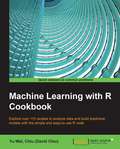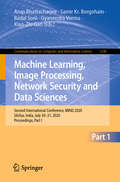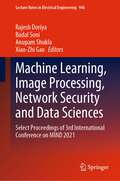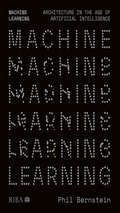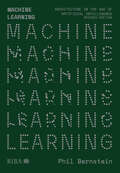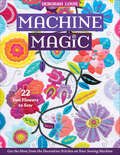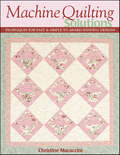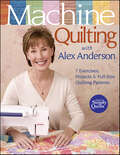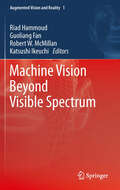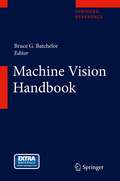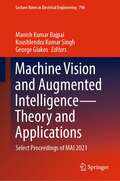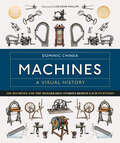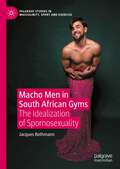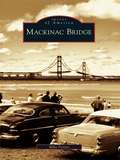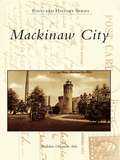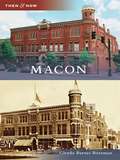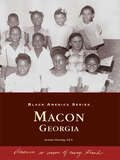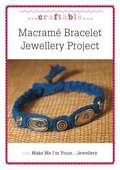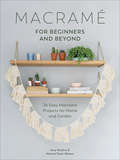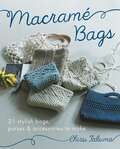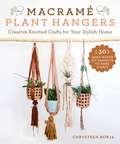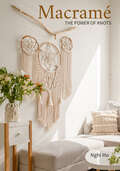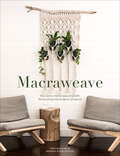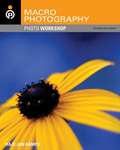- Table View
- List View
Machine Learning with R Cookbook
by Yu-Wei ChiuIf you want to learn how to use R for machine learning and gain insights from your data, then this book is ideal for you. Regardless of your level of experience, this book covers the basics of applying R to machine learning through to advanced techniques. While it is helpful if you are familiar with basic programming or machine learning concepts, you do not require prior experience to benefit from this book.
Machine Learning, Image Processing, Network Security and Data Sciences: Second International Conference, MIND 2020, Silchar, India, July 30 - 31, 2020, Proceedings, Part I (Communications in Computer and Information Science #1240)
by Xiao-Zhi Gao Arup Bhattacharjee Samir Kr. Borgohain Badal Soni Gyanendra VermaThis two-volume set (CCIS 1240-1241) constitutes the refereed proceedings of the Second International Conference on Machine Learning, Image Processing, Network Security and Data Sciences, MIND 2020, held in Silchar, India. Due to the COVID-19 pandemic the conference has been postponed to July 2020. The 79 full papers and 4 short papers were thoroughly reviewed and selected from 219 submissions. The papers are organized according to the following topical sections: data science and big data; image processing and computer vision; machine learning and computational intelligence; network and cyber security.
Machine Learning, Image Processing, Network Security and Data Sciences: Select Proceedings of 3rd International Conference on MIND 2021 (Lecture Notes in Electrical Engineering #946)
by Xiao-Zhi Gao Anupam Shukla Badal Soni Rajesh DoriyaThis book constitutes the refereed proceedings of the Third International Conference on Machine Learning, Image Processing, Network Security and Data Sciences, MIND 2021. The papers are organized according to the following topical sections: data science and big data; image processing and computer vision; machine learning and computational intelligence; network and cybersecurity. This book aims to develop an understanding of image processing, networks, and data modeling by using various machine learning algorithms for a wide range of real-world applications. In addition to providing basic principles of data processing, this book teaches standard models and algorithms for data and image analysis.
Machine Learning: Architecture in the age of Artificial Intelligence
by Phil Bernstein‘The advent of machine learning-based AI systems demands that our industry does not just share toys, but builds a new sandbox in which to play with them.’ - Phil Bernstein The profession is changing. A new era is rapidly approaching when computers will not merely be instruments for data creation, manipulation and management, but, empowered by artificial intelligence, they will become agents of design themselves. Architects need a strategy for facing the opportunities and threats of these emergent capabilities or risk being left behind. Architecture’s best-known technologist, Phil Bernstein, provides that strategy. Divided into three key sections – Process, Relationships and Results – Machine Learning lays out an approach for anticipating, understanding and managing a world in which computers often augment, but may well also supplant, knowledge workers like architects. Armed with this insight, practices can take full advantage of the new technologies to future-proof their business. Features chapters on: Professionalism Tools and technologies Laws, policy and risk Delivery, means and methods Creating, consuming and curating data Value propositions and business models.
Machine Learning: Architecture in the age of Artificial Intelligence
by Phil Bernstein‘The advent of machine learning-based AI systems demands that our industry does not just share toys, but builds a new sandbox in which to play with them.’ - Phil BernsteinThe profession is changing. A new era is rapidly approaching when computers will not merely be instruments for data creation, manipulation and management, but, empowered by artificial intelligence, they will become agents of design themselves. Architects need a strategy for facing the opportunities and threats of these emergent capabilities or risk being left behind.Architecture’s best-known technologist, Phil Bernstein, provides that strategy. Divided into three key sections – Process, Relationships and Results – Machine Learning lays out an approach for anticipating, understanding and managing a world in which computers often augment, but may well also supplant, knowledge workers like architects. Armed with this insight, practices can take full advantage of the new technologies to future-proof their business.Features chapters on: Professionalism Tools and technologies Laws, policy and risk Delivery, means and methods Creating, consuming and curating data Value propositions and business models.
Machine Magic: Get the Most from the Decorative Stitches on Your Sewing Machine; 22 Fun Flowers to Sew
by Deborah LouieLearn how to use your sewing machine to apply gorgeous appliqué stitches to your quilts with this guide featuring four projects and twenty-two designs. Take advantage of everything your sewing machine has to offer! Decorative quilt artist Deborah Louie teaches how to use the stitch options on your machine and incorporate them into gorgeous appliqué pieces. Follow her step-by-step process of building and adding decorative stitches to individual flowers, then applying them to the background with free-motion decorative stitching. Also, learn how to combine stitches and adjust stitch widths and lengths to create your unique stitch garden. Gain confidence in using your machine while also creating bright and bold floral creations! · Make the most of your sewing machine and learn to use decorative stitching · Step-by-step instructions for building and applying decorative stitches to individual flowers, leaves, and clamshells · Includes four projects and patterns for twenty-two flowers plus leaves and clamshells that can be combined for an endless variety of artwork in bloom
Machine Quilting Solutions: Techniques for Fast & Simple to Award-Winning Designs
by Christine MaracciniYou Really Can Quilt Every Top You Make! Quilting your projects is just as much fun as piecing them can be Learn to "decode" your quilts to complete your quilt top Freehand 49 topstitching designs that can be used time and time again with no marking Did you know that your tops can tell you exactly how to quilt them? It’s true! Expert machine quilter Christine Maraccini guides you through every step, taking cues from the intended use of the quilt and the shapes and patterns created by your piecing and appliqué. Discover no-mark-motifs that fit each space and learn the techniques to apply them to your own unique quilt. Includes complete, step-by-step instructions for 6 quilts, including 3 different quilting options for each and 9 trapunto templates! *Important Note about PRINT ON DEMAND Editions: All sales are final - PODs are non-returnable and non-refundable. This title will be printed after purchase and will arrive separately from any in-stock items. Allow minimum 2 weeks for USA delivery, and additional 2 weeks for international shipments. Expedited shipping not available. Print quality will vary from the original offset-printing edition and will be printed on uncoated (non-glossy) paper. The information presented is the same as the most recent printed edition. Pattern pullouts (if applicable) have been separated and presented as single pages.
Machine Quilting With Alex Anderson: 7 Exercises, Projects & Full-Size Quilting Patterns
by Alex AndersonMachine Quilting Is a Snap When Alex Shows You How! • 7 exercises and 7 projects teach you everything from easy straight-line quilting to stippling to more complex motifs • Create lovely traditional quilts using the full-size quilting patterns • Alex makes it easy, with expert tips and techniques on everything from workspace setup to perfecting the quilting stitch Who else but Alex could make machine quilting easy enough for all of us, and so much fun we can’t wait to get started? Learn to set up your space, adjust your machine, choose the right supplies, and mark and baste your quilt. And, oh, you’re going to love these gorgeous projects!
Machine Vision Beyond Visible Spectrum
by Riad Hammoud Katsushi Ikeuchi Robert W. Mcmillan Guoliang FanThe material of this book encompasses many disciplines, including visible, infrared, far infrared, millimeter wave, microwave, radar, synthetic aperture radar, and electro-optical sensors as well as the very dynamic topics of image processing, computer vision and pattern recognition. This book is composed of six parts: * Advanced background modeling for surveillance * Advances in Tracking in Infrared imagery * Methods for Pose estimation in Ultrasound and LWIR imagery * Recognition in multi-spectral and synthetic aperture radar * Fusion of disparate sensors * Smart Sensors
Machine Vision Handbook
by Bruce G. BatchelorThe automation of visual inspection is becoming more and more important in modern industry as a consistent, reliable means of judging the quality of raw materials and manufactured goods . The Machine Vision Handbook equips the reader with the practical details required to engineer integrated mechanical-optical-electronic-software systems. Machine vision is first set in the context of basic information on light, natural vision, colour sensing and optics. The physical apparatus required for mechanized image capture - lenses, cameras, scanners and light sources - are discussed followed by detailed treatment of various image-processing methods including an introduction to the QT image processing system. QT is unique to this book, and provides an example of a practical machine vision system along with extensive libraries of useful commands, functions and images which can be implemented by the reader. The main text of the book is completed by studies of a wide variety of applications of machine vision in inspecting and handling different types of object.
Machine Vision and Augmented Intelligence—Theory and Applications: Select Proceedings of MAI 2021 (Lecture Notes in Electrical Engineering #796)
by Manish Kumar Bajpai Koushlendra Kumar Singh George GiakosThis book comprises the proceedings of the International Conference on Machine Vision and Augmented Intelligence (MAI 2021) held at IIIT, Jabalpur, in February 2021. The conference proceedings encapsulate the best deliberations held during the conference. The diversity of participants in the event from academia, industry, and research reflects in the articles appearing in the volume. The book theme encompasses all industrial and non-industrial applications in which a combination of hardware and software provides operational guidance to devices in the execution of their functions based on the capture and processing of images. This book covers a wide range of topics such as modeling of disease transformation, epidemic forecast, COVID-19, image processing and computer vision, augmented intelligence, soft computing, deep learning, image reconstruction, artificial intelligence in healthcare, brain-computer interface, cybersecurity, and social network analysis, natural language processing, etc.
Machines A Visual History: 100 Machines and the Remarkable Stories Behind Each Invention
by Dominic ChineaThe Repair Shop's Dom Chinea takes you on an exploration of more than 120 essential machines found in the workshops and studios of the world's finest artisans and heritage craftspeople.Having covered tools in his first book, Dominic Chinea turns his attention to machines. Featuring more than 120 machines, defined as items with a mechanism to help transfer energy, Dom looks at objects, including the potter's wheel, grain mill, sewing machine, printing press, wheel maker, and plenty more. Each machine has a fascinating history and story to tell that highlights its contribution to artisanal crafts. And with every machine accompanied by beautifully ornate illustrations by Lee John Philips, it's certain to be a treasured book for all creators and craftspeople.
Macho Men in South African Gyms: The Idealization of Spornosexuality (Palgrave Studies in Masculinity, Sport and Exercise)
by Jacques RothmannThis book explores the experiences of self-identified heterosexual and gay men in contemporary South African gym contexts, particularly as it relates to how the intersection of spornosexual and inclusive masculinities inform their views and enactment of their masculine and sexual identities. Chapters engage with findings from an in-depth qualitative sociological exploration on issues surrounding these masculinities among men living in South Africa who engage in gym work. The author demonstrates that men, when given the opportunity to reflect on their own and the masculinity of others, acknowledge how they promote softer, kinder, disciplined, playful, and sexually agentic masculinities through their look and touch.
Mackinac Bridge
by Mike FornesOn November 1, 1957, traffic officially opened on the Mackinac Bridge. That was the culmination of 70 years of talking and dreaming about a bridge acrossthe Straits of Mackinac, of discouraging attempts for legislative and congressional approval, of efforts to raise the funds, and finally of a three-year construction program necessary for the world's longest and costliest (to date) suspension bridge.Michigan's greatest symbol is expertly maintained, fully funded, and amazingly resilient to the many forces and factors of man and nature that have failed to seriously affect its status as the lone highway link between Michigan's two main peninsulas. The "miracle bridge" at the Straits of Mackinac truly allows a view that epitomizes the state motto of Michigan, Si quaeris peninsulam amoenam, circumspice, or "If you seek a pleasant peninsula, look about you."
Mackinaw City
by Madeline Okerman AdieRich in history, magnificent in scenery, and abundant in hospitality, Mackinaw City lies at the very tip of Michigan's Lower Peninsula and is the area's own majestic playground. From early Native American settlements, French explorers, and fur traders to Mackinaw City founding father Edgar Conkling's vision to build a business center upon the south shore of the Mackinac Straits, Mackinaw City does not disappoint anyone who visits it. Due to its strategic location on the crossroads of the Great Lakes, this area has always been a gathering place for early inhabitants. When the railroad arrived in the late 1800s, it provided needed transportation with unique railroad and car ferries to and from Michigan's Upper Peninsula. Today Mackinaw City still enjoys the distinction of being one of the most popular historical resort areas in Michigan. Through the insight of talented individualswho had the foresight to capture history with the interesting and colorful medium of the postcard, one is able to learn and smile at Mackinaw days gone by.
Macon
by Glenda Barnes BozemanKnown as the "Heart of Georgia," Macon was an affluent city by the time of the Civil War and escaped the destruction that accompanied Sherman's march to the sea. During Macon's prosperous Victorian period, opulent residences and ornate public buildings were constructed; these, along with those of the antebellum period, have been preserved. Author Glenda Barnes Bozeman resides in nearby Gray, Georgia. Originally from history-rich Pensacola, Florida, and as a Florida Pioneer Descendant, Glenda's love for history and historic places inspired the research that led to Then & Now: Macon.
Macon County
by Dan GuilloryMacon County occupies nearly 600 square miles of fertile farmland in the geographic center of Illinois. Abraham Lincoln made his first Illinois home here, on a pleasant bluff overlooking the Sangamon River, near presentday Harristown. On May 10, 1860, he was first nominated for the presidency in Decatur, the county seat. During the World War I era, Macon County boasted over a dozen hamlets and villages, including Warrensburg and Maroa, which both enjoyed opera houses and busy train stations. Maroa was home to John Crocker, who became a famous banker, while nearby Forsyth produced Black Bart, the infamous bank robber. After World War II, Decatur became known as the "soybean capital of the world." And today, agricultural and industrial workers depend on one another, growing and processing the corn and soybeans that have made Macon County a self-sustaining economic engine.
Macon, Georgia (Black America Series)
by Jeanne Herring Ed.S.In this engaging new visual history showcasing Macon's African Americans, vintage photographs illuminate the contributions and achievements of black citizens who have lived and worked in the heart of Georgia for more than one hundred and fifty years. Local landmarks, such as the Douglass Theater and the Harriet Tubman Museum, and unique African-American communities, such as Summerfield and Pleasant Hill, are testament to the indelible mark left on Macon by its enterprising black residents.
Macrame for Beginners and Beyond: 24 Easy Macrame Projects for Home and Garden
by Amy Mullins Marnia Ryan-RaisonDiscover a fresh, new take on the traditional craft of macrame, a craft that was incredibly popular in the seventies, and which is currently enjoying a renaissance. Macrame projects are the best way to bring the current trend for luxe, boho interiors into your home. This title includes very on trend macrame projects for inside and outside the home. Choose from 12 different projects with an 'easy' and 'more advanced' version for each so you can develop your skills as you go. Learn all the basic macramé knots with the knot tutorial library so you can get started with your favourite projects straight away, whether it's the ubiquitous hanging plant holder or a stunning statement arch for the garden or a doorway.
Macramé Bags: 21 Stylish Bags, Purses & Accessories to Make
by Chizu TakumaCraft your own stylish accessories worthy of a high-end boutique with this collection of 21 macramé bags, belts, and straps.From durable market totes to cross-body boho bags, there&’s a purse for every occasion. After mastering basic macramé techniques, discover how to add special details, such as wooden handles, metal buckles, and zippers, to elevate the style and function of your designs. With its assortment of small-scale projects, this book is great for beginners, but also provides fresh inspiration for veteran macramé enthusiasts looking to create wearable art.
Macramé Plant Hangers: 30 Creative Knotted Crafts for Your Stylish Home
by Chrysteen BorjaAdorn your cozy interiors with hand-woven knotted art and hanging plants.Are you a DIY home decorator, plant lover, or flower lover? We got you!Macramé plant hangers are the perfect little touch to accent your cozy, designer home. Macramé—the art of knotting made popular in the seventies—is now on a revival, bringing trendy boho vibes into your living room, bedroom, and more. And there&’s simply no better way to display your hanging plants than stringing them up in handmade woven knots.Whether you&’re a novice or seasoned knotter, Macramé Plant Hangers provides thirty quirky, yet stunning projects that will spark your DIY artist&’s imagination and get you creating. Follow detailed photographs and instructions to construct patterns with various natural fibers, including cotton rope, felted wool, silk ribbon, jute, recycled fabric, and more. There are knotted projects suitable for bigger eight-inch pots, small four-inch pots, vintage bottles, and even air plants.Including a practical beginner&’s section of knot basics; an introduction to weaving; customizable variations to add playful beads, funky fringes, and chic rope tassels to your macramé design for &“whimsy&”; and a bonus chapter on special projects that mix macramé with a dash of weaving and earthy elements, Macramé Plant Hangers is your handy guidebook to adorning interiors with your own custom hand-knotted, vintage art you can be proud of—while keeping it green!
Macramé: The Power of Knots
by Nghi HoLearn and Master the Art of Macramé“A wonderful resource for beginning and advanced macramé artists.” ―Elizabeth Majka, Library Journal#1 New Release in Ribbons, Knots, Macrame & Rope WorkLearn the art of macramé and craft beautiful and practical creations such as wall hangings, plant hangers, jewelry, and much more.Develop a new creative hobby or just improve your macramé skills. New to macramé or an accomplished macramé artist? Either way, with the expert guidance of author Nghi Ho, online macramé community star and founder of Miss Knottie Macramé supplies, you’ll discover new macramé patterns and projects and a whole world of enjoyment and satisfaction.Relax with macramé DIY crafts. Having a stressful day? Unwind with a macramé project that can be both gratifying and fun. If you are new to macramé, Nghi Ho will show you how to get started, explain the basic materials you’ll need, and give you a good grounding in macramé knots.Inside find:Tutorials on starting your own macramé projects, macrame kits, and basic knotsCrafts to do at home and fun activities for the whole familyMacramé projects that are unique and personalizedIf you have read books like Macramè For Beginners, Statement Macramé, or Modern Embroidery, you’ll love Nghi Ho’s Macramè: The Power of Knots.
Macraweave: Macrame Meets Weaving with 18 Stunning Home Decor Projects
by Amy Mullins Marnia Ryan-RaisonDiscover the exciting new craft that brings together two timelessly popular fiber arts to make beautiful, eye-catching pieces for your home. Learn to create stunning woven wall hangings and inject a dose of &“bohemian luxe&” to your living space. Macraweavecombines the crafts of macramé knotting with weaving to create eye-catching projects that really pop with texture and color. There are eighteen projects to choose from including woven wall hangings, table mats, plant hangers and cushions as well as accessories such as jewelry. All the instructions and projects are illustrated with step-by-step photography.
Macro Photography Photo Workshop
by Haje Jan KampsSpecial techniques for creating unique, artistic, close-up images Macro, or close-up, photography is gaining popularity, and this book covers all of the challenges associated with taking great close-ups: depth of field, focus, and exposure. Copublished with Photoworkshop. com, a leading online educational resource for both beginning and professional photographers, this task-oriented reference allows readers to learn by doing and offers outstanding examples and instructions.
